Want to stay organized, reduce stress, and boost productivity? A simple planner can help you manage your day, track habits, and even express creativity. Here’s why it works:
Whether you’re a student or a professional, using a simple planner can transform your daily life. Keep reading to learn how to make the most of it!
A simple planner acts as your go-to tool for managing daily tasks and responsibilities. Unlike digital tools loaded with features that can sometimes feel overwhelming, a basic planner gives you a clear and focused space to prioritize what matters most.
Whether you prefer a bullet journal or a Hobonichi planner, their straightforward layouts make it easy to track tasks without unnecessary distractions. Plus, physically writing down your plans can boost memory retention and increase the likelihood of completing them [2].
Here are a few ways to get the most out of your planner:
| Planning Element | How It Helps |
|---|---|
| Task Lists | Keeps important items from slipping through the cracks |
| Time Blocks | Helps you manage your time effectively |
| Goal Tracking | Keeps your focus on long-term achievements |
Make it a habit to spend a few minutes each day reviewing your priorities and updating your tasks. This simple routine helps you stay on top of everything and prevents tasks from piling up [4].
With a planner, you don’t need to rely on apps or deal with constant notifications. It’s a dependable tool that works anytime, anywhere – no batteries, no updates required [2]. By streamlining how you manage your tasks, a planner not only keeps you organized but also helps ease the stress of feeling overwhelmed.
Keeping up with everything in today’s fast-paced world can feel overwhelming. A simple planner can help by giving you a space to offload mental clutter and take back control of your day.
Studies show that uncertainty and feeling out of control are major contributors to stress [4]. Writing down your tasks and commitments creates a system you can rely on. This reduces the need to mentally juggle everything, making it easier to focus and prioritize. Plus, the act of writing things down can feel calming, helping to organize your thoughts and bring a sense of order [3].
A planner is also a great tool for breaking big projects into smaller, actionable steps. It allows you to create schedules that prevent last-minute scrambles and gives you a place to map out your ideas. This process clears your mind and boosts your confidence in tackling future goals. The goal isn’t to have a flawless system but to develop a dependable way to manage your daily life. Using a planner isn’t just about staying organized – it’s about creating peace of mind and reducing stress [3].
Spending just a few minutes with your planner each day can turn chaos into order. It helps you stay on top of responsibilities, easing anxiety and freeing up mental energy for better focus and productivity.
Using a planner can help clear mental clutter by addressing the habit of dwelling on unfinished tasks [4]. When you jot down your responsibilities, you free up mental space to concentrate on what matters most right now.
Time-blocking, a method easily supported by basic planners, allows you to assign specific time slots to tasks. This approach helps prevent over-scheduling and keeps your focus sharp [2]. Formats like bullet journals or Hobonichi planners are straightforward enough to make these strategies easy to adopt without feeling overwhelmed.
Planners also help you break down big projects into smaller, actionable steps with clear milestones [2]. This creates a visual guide to track your progress and maintain steady momentum toward your goals.
| Time Management Strategy | How It Improves Productivity |
|---|---|
| Time-blocking | Reduces task overlap and minimizes constant switching between tasks |
| Breaking down tasks | Simplifies large projects and makes progress easier to track |
| Setting priorities | Keeps attention on the most important tasks first |
By using a planner, you gain a clear overview of your tasks, helping you focus on what truly deserves your attention [1].
A simple planner offers structure, reduces the mental strain of juggling commitments [3], and helps you build consistent progress toward your objectives. Over time, this practice not only improves productivity but also helps establish habits that stick.
Using a simple planner can help you stick to daily habits, especially during the critical 66-day period it takes to form them. Formats like bullet journals or basic daily planners are straightforward, reducing the mental resistance that often leads to procrastination.
| Time of Day | Planning Activity | Duration |
|---|---|---|
| Morning | Review daily tasks | 5 minutes |
| Afternoon | Check progress | 2-3 minutes |
| Evening | Prepare for the next day | 5-10 minutes |
Spending just 5–10 minutes a day on planning – whether reviewing tasks in the morning or prepping for the next day at night – can make this habit easier to maintain. Keep your planner in a visible spot to create a visual reminder that reinforces the routine.
Regular use of a planner provides positive feedback, helping you feel more in control of your day. As modAmbition puts it, "Making this a habit really has the power to change your life so that you are less stressed and more in control" [1].
On top of building habits, a planner can also double as a creative outlet, making the process more enjoyable and personal.
Consistency is key for building discipline, but adding personal touches to your planner can make the whole process more fun and engaging. A planner isn’t just a tool for staying organized – it can also be an outlet for creativity and a reflection of your personal style.
Simple planners with clean layouts strike a great balance between structure and flexibility, giving you room to make it your own. Studies suggest that adding creative activities like doodling or decorating to your planning routine can help lower stress and boost overall well-being [1]. This approach not only makes planning more enjoyable but also supports mental clarity and focus [3].
| Creative Element | Purpose/Impact |
|---|---|
| Washi Tape | Helps organize sections and improves visual appeal |
| Color Coding | Makes task categories clear and easy to process |
| Stickers | Highlights important events and adds interest |
| Doodles | Brings personality and fun to your planning |
Themed stickers or functional ones, like checklists and trackers, combine practicality with style. Here’s how to balance creativity with productivity:
Personalizing your planner isn’t just about making it look good – it’s about creating a system that works for you and motivates you to stay organized. When your planner feels like an extension of your personality, you’re more likely to use it consistently and get the most out of it.
A simple planner can help you manage your day-to-day life by cutting down on mental clutter and giving you a clear plan for your tasks and goals. It blends organization, stress relief, productivity, habit tracking, and self-expression into one tool that supports daily success.
By offering structure, a planner helps reduce uncertainty, ease stress, and boost efficiency. It allows you to allocate your time wisely and tackle tasks with intention, making it a dependable tool for managing different aspects of your life [3].
Whether you prefer a rigid schedule or something more flexible, a simple planner fits your style, making it easier to stick with. Formats like bullet journals or Hobonichi planners are easy to use and help you maintain clarity and focus over the long term [2].
| Planning Element | Key Benefit |
|---|---|
| Task Management | Avoids missed tasks and overload |
| Time Allocation | Enhances focus and productivity |
| Progress Tracking | Encourages motivation |
The most effective planner is the one you’ll actually use. Start with basic tasks and adjust as needed. This way, your planning system evolves with you, staying effective in helping you reach your daily goals [2][3].
You don’t have to give up practicality to make your planner more enjoyable. Small tweaks can add personality while keeping things organized. Here are a few ideas:
| Element | Purpose | Example Use |
|---|---|---|
| Color Coding | Organizing tasks | Use different colors for work, personal, and urgent tasks |
| Stickers | Highlighting key points | Mark important dates or milestones with fun stickers |
| Doodles | Adding a personal touch | Draw simple icons or quick sketches in the margins |
You can keep most of your planner functional and set aside small areas for creativity. For instance, try adding quick doodles in the margins or icons to represent different types of activities. This keeps your system effective while making it more engaging [2].
Start with something simple, like assigning colors to different task categories, and build from there as you get more comfortable [3]. The idea is to create a setup that you’ll enjoy using regularly without losing its practicality.
Stickers Made for Planning
Our custom stickers are a fuss-free way to brighten up your planner pages with perfectly-sized designs that add a spark of personality to every layout.
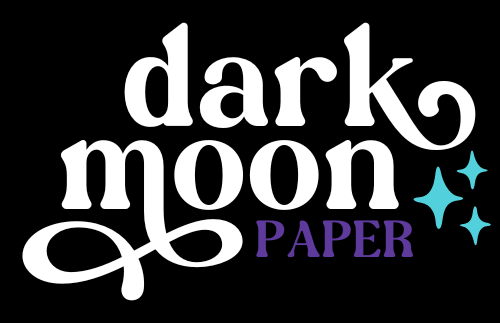
Why use planner stickers?
Planner stickers make organizing easy, fun, and personal! Add color, creativity, and structure to every page, transforming your planner into a tool that reflects you. Perfect for tracking, decorating, and staying inspired daily!
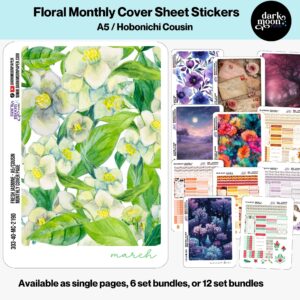
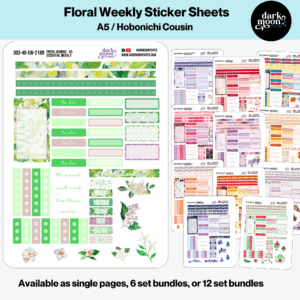
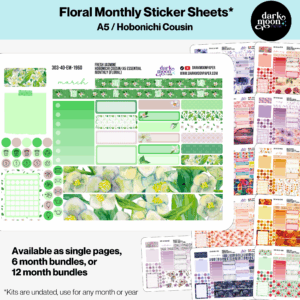
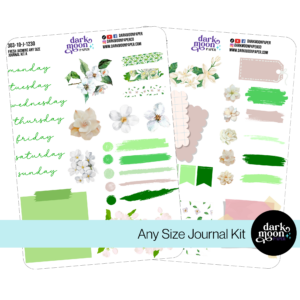
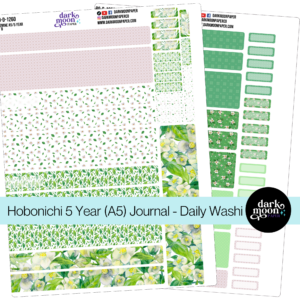
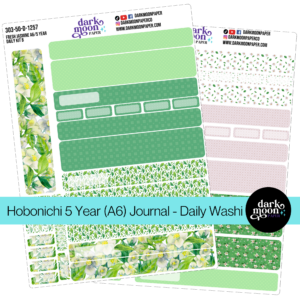
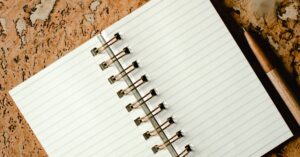
Hello and welcome!
I’m Rachael Snow, a lifelong artist and entrepreneur, and I started Dark Moon Paper to blend my love of art, technology, and the mysterious beauty of the world around us. My sticker kits are meant to set the mood, tell a story, and give you a little escape from the ordinary.
I work from my cozy studio tucked away in the beautiful woods of Oregon, surrounded by nature and a dark night sky full of stars.